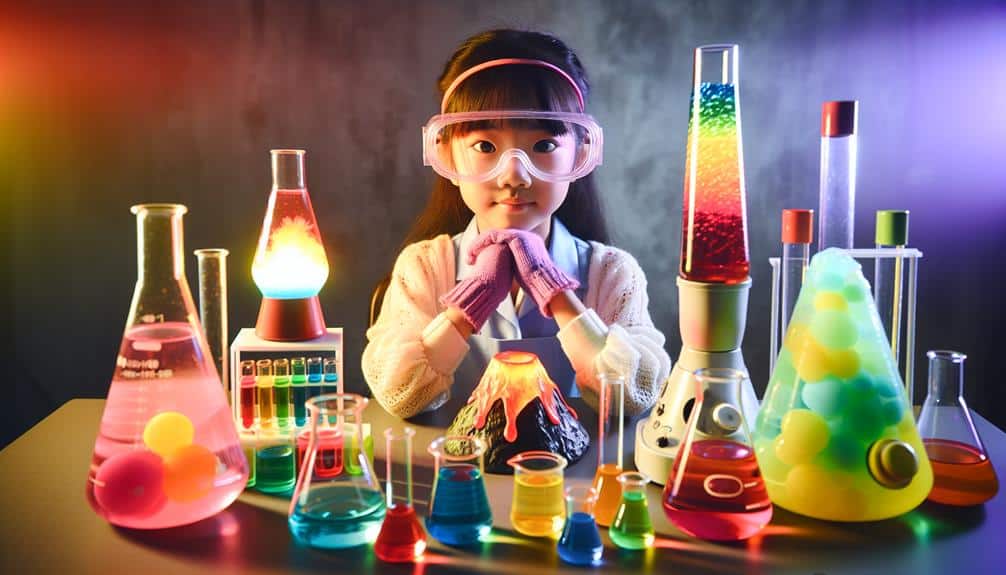Get ready for some homeschool science fun! Try making an easy volcano with baking soda and vinegar – watch it erupt like a real one! Create a colorful Rainbow Density Jar to understand liquids and colors mixing. Have a blast with the Balloon Rocket Challenge by designing your own rockets. Uncover mysteries with Invisible Ink made from lemon juice. Cook up some tasty treats using solar energy with a Solar Oven Project. Keep the excitement going with Homemade Slime and a DIY Lava Lamp! Hands-on learning at its best awaits you!
Key Points
- Create a classic volcano simulation with baking soda and vinegar for an eruptive experiment.
- Explore density and color mixing with a rainbow density jar using corn syrup, oil, and food coloring.
- Design and test balloon rockets to learn about thrust and propulsion through hands-on challenges.
- Uncover secrets with invisible ink made from lemon juice and water, revealing hidden messages with heat.
- Build a solar oven using a pizza box and foil to cook s'mores, teaching sustainability and solar energy.
Easy Volcano Experiment
Let's explore a fun and educational Easy Volcano Experiment that will captivate your child's imagination and curiosity! This experiment involves the classic baking soda and vinegar reaction to create an erupting volcano simulation.
To create your volcano, build a cone shape using modeling clay on a tray. Leave a hollow space in the center where you'll later pour in the ingredients for the eruption.
Once your volcano is ready, mix baking soda with a few drops of dish soap inside the hollow space.
Next, pour vinegar into the mixture and watch as your volcano comes to life with a foamy eruption. The baking soda and vinegar react to produce carbon dioxide gas, which creates bubbles and fizz, resembling a volcanic eruption.
This hands-on activity not only teaches children about chemical reactions but also ignites their curiosity about the natural world. Encourage them to experiment with different amounts of baking soda and vinegar to see how it affects the eruption.
Get ready for some explosive fun with this Easy Volcano Experiment!
Rainbow Density Jar
Discover how to create a mesmerizing Rainbow Density Jar that will amaze and educate your child about the principles of density and layering liquids. This colorful experiment combines elements of color mixing, liquid layers, density exploration, and the creation of a stunning rainbow effect.
To start, gather clear corn syrup, water, vegetable oil, dish soap, rubbing alcohol, and food coloring in various hues. Begin by carefully layering the liquids in a clear jar, starting with the densest liquid, like corn syrup, at the bottom and progressing to the least dense, such as rubbing alcohol, at the top.
As you pour each liquid, observe how they form distinct layers due to their different densities. Add a few drops of different colored food dye to each layer for a vibrant touch. Watch as the colors mix slightly at the boundaries, creating a beautiful rainbow effect within the jar.
Encourage your child to hypothesize about why the liquids stack the way they do and discuss the science behind it. This hands-on activity will captivate your child's curiosity and provide a memorable lesson in science.
Balloon Rocket Challenge
Get ready to launch into excitement with the Balloon Rocket Challenge, a thrilling hands-on experiment that will have your child exploring the principles of thrust and propulsion in a fun and engaging way.
Rocket Design: Encourage your child to get creative with designing their rocket using everyday materials like straws, paper, and tape.
Speed Competition: Challenge them to adjust their rocket design to see how it affects the speed at which their balloon rocket travels.
Balloon Propulsion: Explore the power of balloon propulsion by inflating the balloon and releasing the air to propel the rocket forward.
Distance Test: Set up a course or mark distances to test how far each rocket can travel, allowing your child to learn about the impact of variables on distance covered.
Engage in a friendly competition, experiment with different designs, and watch as your child learns about physics through this interactive Balloon Rocket Challenge.
Invisible Ink Investigation
Explore your inner detective as you immerse yourself in the intriguing world of invisible ink investigation. Unravel the mysteries hidden within secret messages using simple chemical reactions. This DIY science experiment will have you feeling like a real spy, using techniques similar to those found in historical spy gadgets.
To create your invisible ink, start by mixing lemon juice with water in a bowl. Dip a cotton swab or paintbrush into the mixture and write your message on a piece of paper. Allow the paper to dry completely.
When you're ready to reveal the hidden message, hold the paper up to a heat source, such as a light bulb or a candle. The heat will cause the lemon juice to oxidize and turn brown, making your message magically appear.
Historically, invisible ink has been used by spies to send confidential messages without detection. Now, it's your turn to experiment with this fun and educational activity at home.
Solar Oven Project
Ready to harness the power of the sun and cook up some tasty treats? Solar cooking isn't only fun but also a sustainable way to utilize renewable energy. By building your solar oven, you can learn about sunlight absorption and energy efficiency while making delicious snacks.
Here's a guide to get you started:
- Materials Needed: Gather a pizza box, aluminum foil, plastic wrap, black construction paper, and tape.
- Construction: Line the inside of the pizza box with aluminum foil, place the black construction paper at the bottom, and cover the box's opening with plastic wrap.
- Food Preparation: Choose easy recipes like s'mores, nachos, or mini pizzas that can cook quickly in the solar oven.
- Cooking Process: Position your solar oven in direct sunlight and adjust it throughout the day to ensure maximum sunlight absorption for best energy efficiency.
With your DIY solar oven, you'll not only enjoy tasty snacks but also gain a hands-on understanding of solar energy and sustainability.
Homemade Slime Fun
Ignite your creativity with this hands-on and engaging activity of making homemade slime! Homemade slime is a fantastic way to explore science while having a blast. There are various slime variations you can experiment with, like fluffy slime, glitter slime, or even glow-in-the-dark slime. Each type offers a unique sensory experience, making it a perfect choice for sensory play benefits.
Creating slime involves mixing simple ingredients like glue, water, and a slime activator such as borax or contact lens solution. The process of combining these elements leads to a fascinating chemical reaction that results in stretchy, gooey slime. As you knead and play with the slime, you engage your senses, enhancing tactile awareness and providing a calming effect.
Homemade slime not only entertains but also introduces children to basic scientific concepts in a fun way.
DIY Lava Lamp Experiment
Get ready to create a mesmerizing DIY lava lamp that will captivate your senses and teach you about the fascinating world of density and buoyancy!
This simple experiment uses oil, water, food coloring, and bubbles to demonstrate these scientific principles in action.
- Oil and Water: Explore how oil and water don't mix due to their different densities.
- Food Coloring: Watch as the food coloring adds a burst of color to your lava lamp, showing how liquids of different densities interact.
- Bubbles: Observe the bubbles rising and falling within your lava lamp, showcasing the effects of buoyancy.
- Creating Motion: Discover how mixing the ingredients creates a mesmerizing swirling effect that mimics a real lava lamp.
Frequently Asked Questions
Can These Experiments Be Done With Common Household Items?
With just household items, you can transform your learning space into a science lab. No need to break the bank – budget-friendly swaps and creative twists make these experiments eco-friendly and fun for all.
Are These Experiments Safe for Children to Conduct Alone?
Parental supervision is necessary for safety. Some experiments involve heat, chemicals, or small parts. Always consider potential hazards before letting children conduct experiments alone. Guarantee a safe environment and enjoy learning together!
How Can These Experiments Be Adapted for Different Age Groups?
As you explore adapting science experiments for various ages, consider age-appropriate modifications. Encourage group participation to enhance hands-on learning and critical thinking skills. Engage young minds through interactive experiments tailored to their developmental stage.
Can the Materials Used in These Experiments Be Easily Found?
You'll easily find the materials for these experiments at home or local stores. DIY science experiment resources like online guides offer alternative materials if needed. Enjoy exploring and learning with accessible supplies!
Are There Any Additional Safety Precautions Parents Should Be Aware Of?
So, you want to explore those cool science experiments, huh? Remember, safety measures are key! Keep a close eye on your little scientist, watch out for experiment hazards, and guarantee parental supervision throughout.



